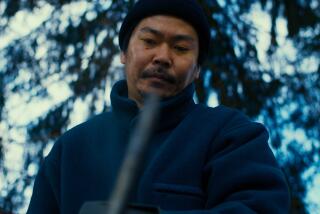FILM : Akira Kurosawa’s ‘Stray Dog’ Knows Where It’s Going
- Share via
Akira Kurosawa’s “Stray Dog” (Nora-Inu) begins with a small crime, when a pickpocket steals a gun from a young cop during a crowded bus ride.
This sets in motion an edgy journey through postwar Tokyo as the detective, played by a very lean and hungry Toshiro Mifune, tries to track down the gun, which he learns now belongs to a killer. Like the detective, the killer is a former soldier who has suffered since the war ended, and both men have a self-destructive streak.
The 1949 film (screening at the Wilshire Auditorium in Fullerton Friday night) is just one example of Kurosawa taking a genre and molding it to his own needs. As he did with Shakespeare (“Throne of Blood” and “Ran,” which borrow from “Macbeth” and “King Lear,” respectively) and the American Western (“Yojimbo”), Kurosawa embraced the detective movie, turning it into a revealing commentary.
A good yarn (based on an actual case, by the way), “Stray Dog” is unique because it builds on an awareness of the desperation that accompanied Japan’s early adjustment to defeat in the war. In his search for the pistol, Mifune’s character, Murakami, descends into a Tokyo that seems to be staggering through a fallout of immorality and violence. Kurosawa blurs the line between right and wrong, showing the ambiguities of the times.
Even Murakami’s motivations raise questions about the war’s aftermath. He explains to his partner (Takashi Shimura) that he became a cop to fill the moral vacuum and anger he felt after returning home. Murakami confesses that he might have turned to crime, like the murderer (Ko Kimura) he’s trailing, if he hadn’t become a detective. It’s his identification with the killer that makes Murakami’s investigation so compulsive.
Beyond this layering, “Stray Dog” is one of Kurosawa’s more simply enjoyable films. He and fellow screenwriter Ryuzo Kikushima never lose sight of the components that make a good crime movie: The characters are richly authentic, the locales colorful and surprising, and the plot has a steady velocity leading up to a satisfyingly just resolution.
Along the way, we’re treated to customarily sensual Kurosawa imagery. Murakami trudging through the Tokyo ghetto, disguised as a criminal. The bored-looking chorus girls barely getting through a comic Broadway-styled dance routine. The speedy shots of a Japanese baseball game. The final confrontation between Murakami and the murderer in a dense, deserted field.
Even the opening credits, where a panting dog fills the entire frame, makes an impression. Later, when Murakami’s partner reminds him that “a stray dog becomes a mad dog,” a warning to Murakami to check his own passions, these first images come to mind in dramatic fashion.
What: Akira Kurosawa’s “Stray Dog” (Nora-Inu).
When: Friday, June 7, at 7:30 p.m.
Where: The Wilshire Auditorium, 330 N. Lemon St., Fullerton.
Whereabouts: Take the Riverside (91) Freeway to Lemon Street and head north.
Wherewithal: $4 and $5.
Where to Call: (714) 871-4030, Ext. 15.
More to Read
Only good movies
Get the Indie Focus newsletter, Mark Olsen's weekly guide to the world of cinema.
You may occasionally receive promotional content from the Los Angeles Times.










